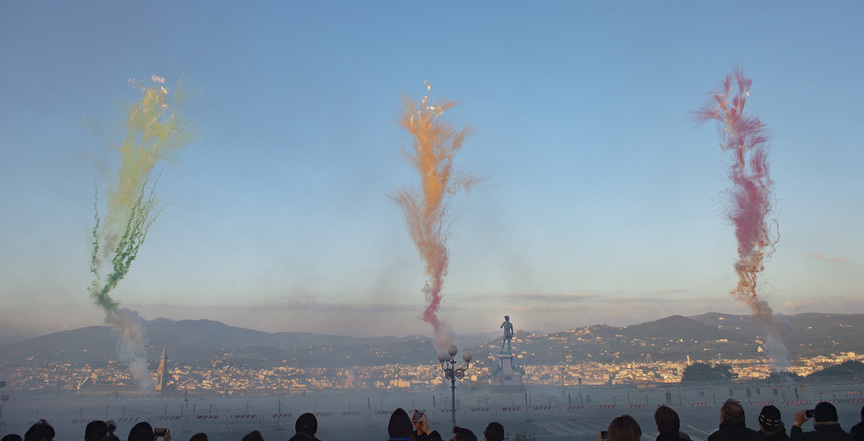-
From Current Issue
-
- Editor’s Letter Fire in the Heart
- Reviews I Gusti Ayu Kadek Murniasih
- Reviews 11th Seoul Mediacity Biennale: “One Escape at a Time”
- Dispatch Networked China
- One on One Monira Al Qadiri on Yukio Mishima
- Essays The rise of independent art spaces in pandemic-era Shanghai
- Features Tuan Andrew Nguyen
- Table of Contents
- Web Exclusives
- Archive
- Subscribe

R
E
V N
E
X
T
Installation view of CAI GUO-QIANG’s “Flora Commedia: Cai Guo-Qiang at the Uffizi” at Uffizi Galleries, Florence, 2018. Photo by Wen-You Cai. Courtesy Cai Studio.
Thunderous rumbles marked the opening of “Flora Commedia: Cai Guo-Qiang at the Uffizi” as 50,000 fireworks filled the sky above Florence with cascades of multicolored blooms during the pyrotechnic event City of Flowers in the Sky, one of Cai’s most spectacularly choreographed to date, inspired by the work of Renaissance painter Sandro Botticelli. The beauty of Renaissance flowers was the central theme of the exhibition, the first solo show of a Chinese contemporary artist by the Italian museum, co-curated by Uffizi director Eike Schmidt and Laura Donati, who leads the department of prints and drawings.
Renowned for his fireworks performances and complex installations, Cai has returned lately to his signature technique of gunpowder painting, which entails laying gunpowder, cardboard stencils and fuses on paper or canvas and igniting them in a blast that leaves charred patterns. To define the resulting image, Cai uses ignited incense sticks, triggering more directional micro-explosions. Cai’s recent interest in a deeper engagement with Western painting has led him on “An Individual’s Journey Through Western Art History,” a project that in 2017 took him first to the Pushkin State Museum of Fine Arts in Moscow, then to the Prado Museum in Madrid, where he staged a solo show in dialogue with Spanish Old Masters, and subsequently to Florence, where he researched Italian Renaissance flora at the Uffizi’s print and drawing department. Cai was also impressed by the Boboli Gardens at the Pitti Palace, where botanists recreated for him plants and flowers that originally grew in 15th century gardens. As the artist explained during the exhibition’s opening “Flowers, with their wild colors and shapes, embody the free spirit of the Renaissance, an epoch that placed humanity with its feelings and emotions at the center of artistic and philosophical thought.”
“Flora Commedia” unfolded through a sequence of adjoining rooms, leading the viewer through differently themed “gardens.” Stepping into the “Renaissance Garden,” one was immersed in a colorful atlas of flora. Forty paintings and sketches covering almost the entire wall surface testified to Cai’s sensitive observation of a variety of peculiar flower species. A Bouquet of Flowers 2 (all works 2018) is impressionistically rendered with abstract bursts of intense blue, purple and green gunpowder. The diaphanous beauty of white lilies is minimally and elegantly depicted with few traits of gray and touches of yellow, recalling the delicacy of Renaissance Silverpoint drawings from the Uffizi’s collection. In the “White Garden,” Dandelion No. 3 and 4 feature spherical stamens similar to planets, their surfaces pitted by explosions of black gunpowder, like tiny volcanoes erupting pollen.
A room was dedicated to the late-Renaissance master Michelangelo Merisi da Caravaggio, whom Cai greatly admires; as he explained during the press conference: “With Caravaggio, I share the rebellion. He couldn’t stand rules, and that’s also the reason why I started painting with gunpowder. It’s a very unpredictable material.” As a humorous homage to the Renaissance painter’s untamed character, Cai’s self-portrait after Caravaggio’s Head of Medusa (circa 1597–98) was titled Bad Kid!. However, unlike Caravaggio’s monstrous Gorgon, the image of the artist’s blood-spurting head materializing from a foggy, indistinct background surrounded by wriggly and squirming lines, created an impression of human frailty and powerlessness.
A striking, large-scale canvas, I Modi, resonates at once with the aesthetics both of Renaissance frescoes and the Japanese erotic art of shunga. The piece was inspired by the titular 1524 book, one of the first banned publications in Europe, containing 16 images of different sexual positions. Cai condenses the scenes into a single composition depicting 16 moments of a single sexual encounter, the emotional intensity of which is enhanced by blasts of yellow, ocher, purple and black. With a veritable display of bravura, the piece cross-pollinates the aesthetics of Japanese and Renaissance erotic imagery, injecting it with vibrant energy.
“Flora Commedia” was an enticing and comprehensive show foregrounding the richness and complexity of Cai Guo-Qiang’s expressive and layered art practice. Moreover, it confirmed Cai’s status as a global artist, perfectly at ease with freely navigating between many different cultural heritages while creating something completely original.
Cai Guo-Qiang’s “Flora Commedia” is on view at the Uffizi Galleries, Florence, until February 17, 2019.
To read more of ArtAsiaPacific’s articles, visit our Digital Library.





















